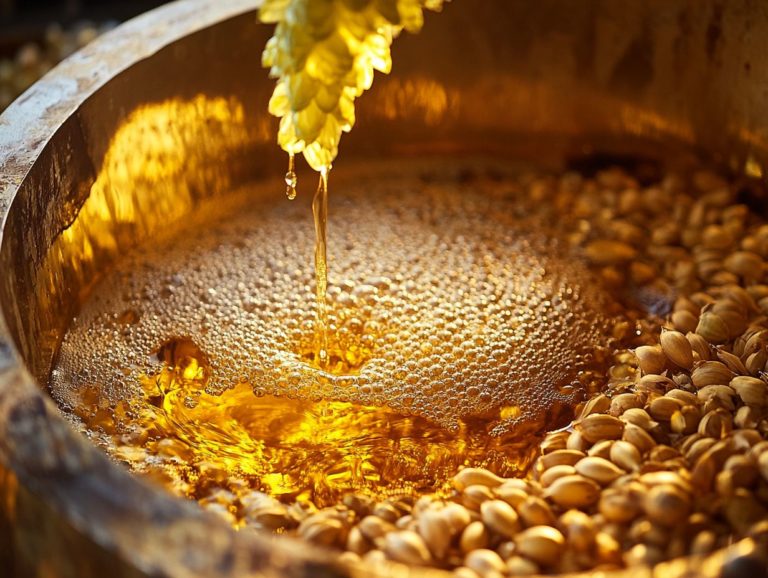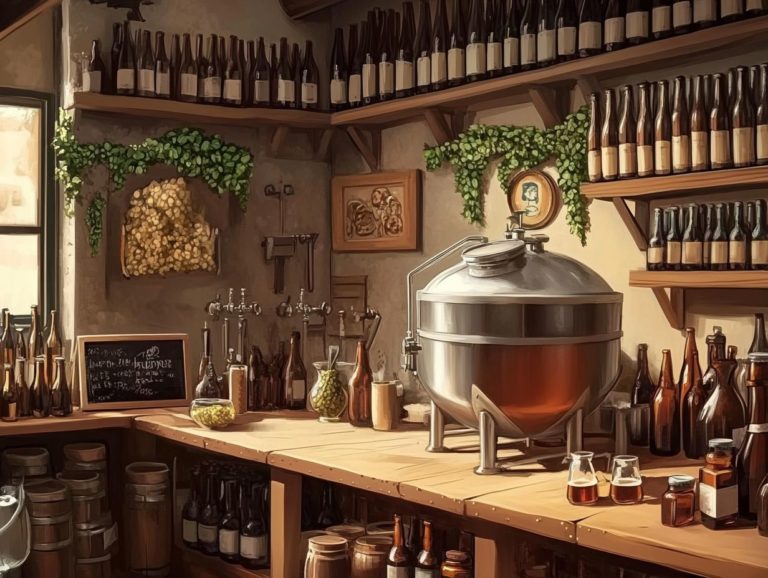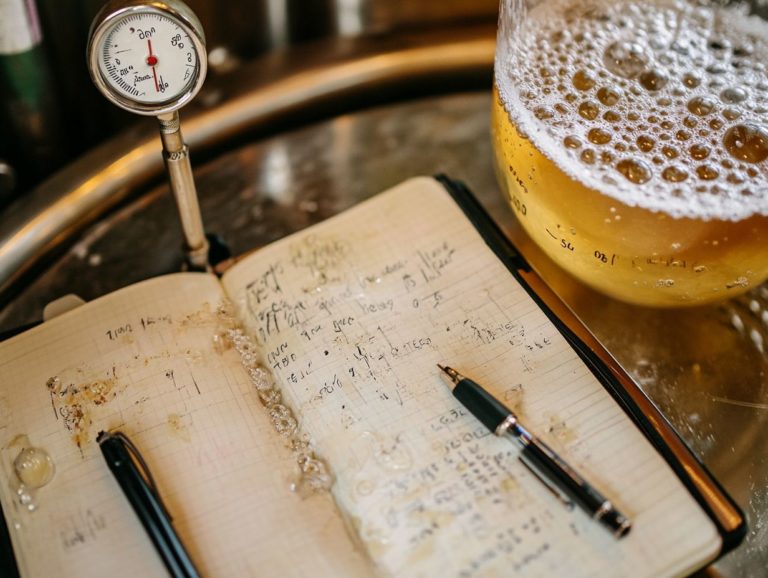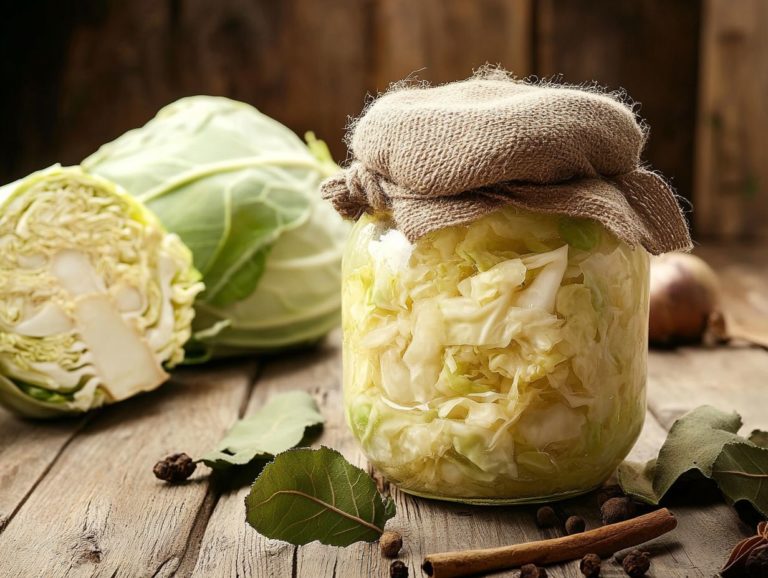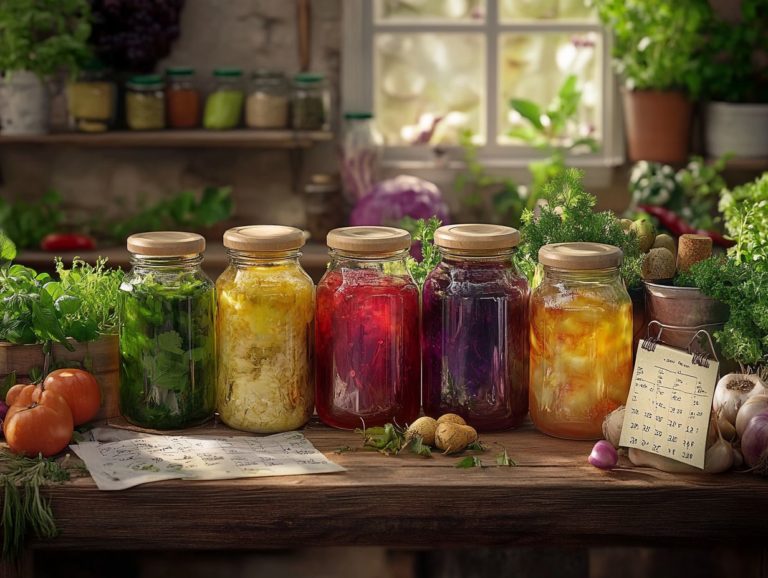Exploring Fermentation Flavors in Craft Beer
Fermentation serves as the heartbeat of craft beer, transforming simple ingredients into a captivating symphony of flavors that tantalize your palate. This article delves into the intricate art and science of fermentation, shedding light on how it significantly influences the taste and character of your favorite brews.
From exploring the various types of fermentation to understanding the vital roles that yeast and hops play, you will discover the essential ingredients and techniques that brewers employ. These elements create unique flavors influenced by the brewing environment and environmental conditions.
Explore the enchanting world of esters and phenols, which are compounds produced during fermentation that contribute to beer’s aroma and flavor. Discover how innovative brewers are continually pushing the boundaries of flavor in the dynamic realm of craft beer, incorporating ancient techniques and unique contributions from wild microorganisms.
Contents
- Key Takeaways:
- What Is Fermentation in Craft Beer?
- How Does Fermentation Affect the Flavor of Beer?
- What Are the Different Types of Fermentation in Beer?
- What Are the Key Ingredients in Fermentation?
- What Role Do Yeast Play in Fermentation?
- What Are the Most Common Flavors Produced by Fermentation?
- What Are Esters and How Do They Affect Beer Flavor?
- What Are Phenols and How Do They Contribute to Beer Flavor?
- How Can Brewers Control and Manipulate Fermentation Flavors?
- What Techniques Can Be Used to Enhance or Suppress Certain Flavors?
- How Do Different Strains of Yeast Impact Flavor Profiles?
- What Role Do Temperature and Time Play in Fermentation Flavors?
- What Are Some Examples of Unique Fermentation Flavors in Craft Beer?
- What Are Some Popular Styles That Showcase Unique Fermentation Flavors?
- What Is the Future of Fermentation in Craft Beer?
- How Are Brewers Pushing the Boundaries of Flavor Through Fermentation?
- What New Techniques and Ingredients Are Being Explored in Fermentation?
- Frequently Asked Questions
- What is fermentation in craft beer?
- How does fermentation affect the flavor of craft beer?
- What are some common fermentation flavors found in craft beer?
- Can fermentation flavors vary between different types of craft beer?
- Are there any techniques that can enhance or alter fermentation flavors in craft beer?
- How can one best explore and appreciate fermentation flavors in craft beer?
Key Takeaways:
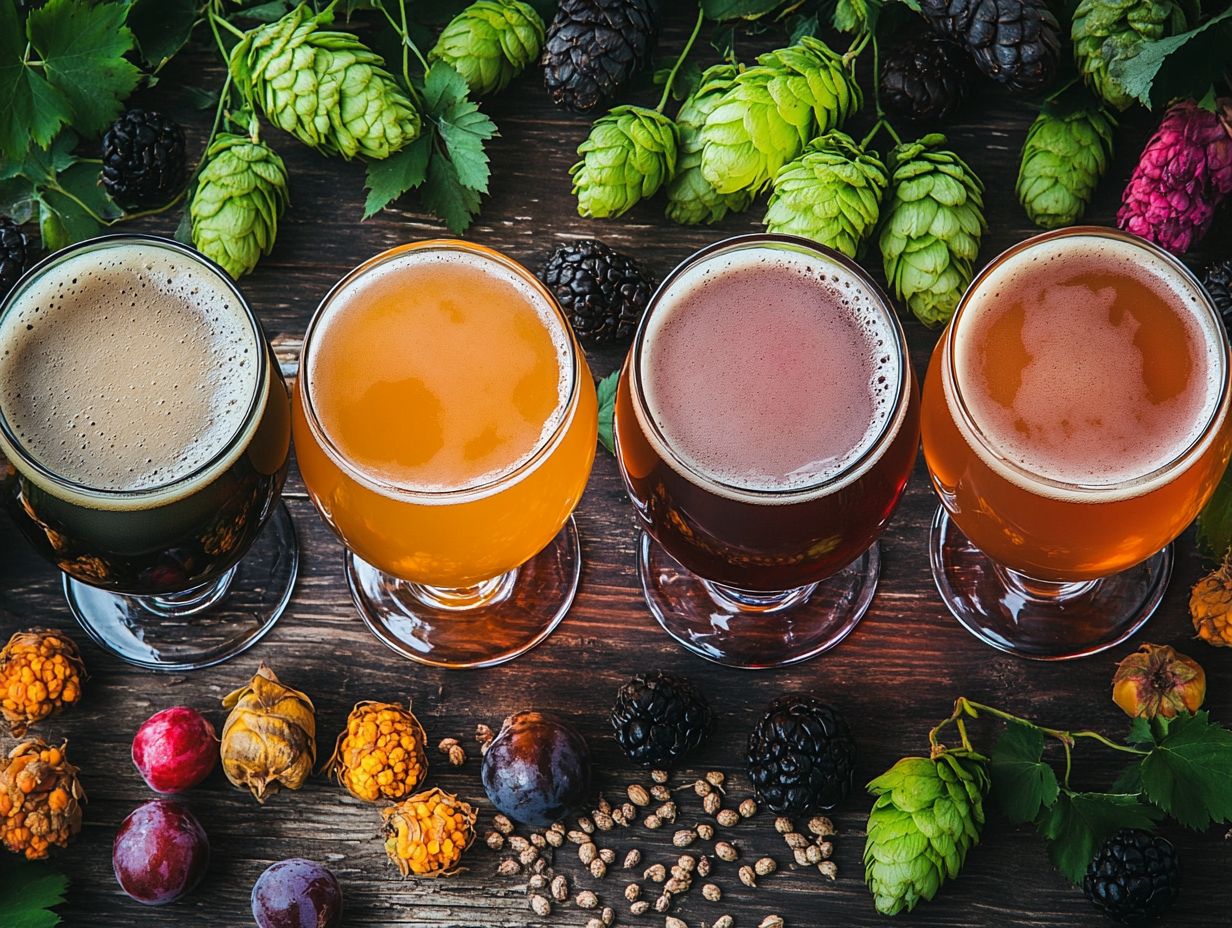
What Is Fermentation in Craft Beer?
Fermentation in craft beer is a captivating technique that transforms simple ingredients into a symphony of complex flavors. This results in unique brews that showcase the true artistry of brewing.
This intricate process harnesses the power of wild yeast and lactic acid bacteria, along with various fermentation methods. It produces an impressive array of flavor profiles, similar to how different beer characteristics emerge.
From the rich depth of Belgian lambic to innovative beers crafted through time-honored techniques, fermentation is essential in defining the character of each creation. By understanding these fermentation techniques, which include traditional methods and brewing innovations, you can elevate your brewing experience and enrich your knowledge as a beer enthusiast or aspiring brewer.
How Does Fermentation Affect the Flavor of Beer?
Fermentation shapes the flavor of beer. This is when yeast and bacteria interact with sugars, creating unique flavor compounds that characterize each brew’s distinct personality.
The brewing methods you choose and the specific strains of yeast you use can lead to an astonishing array of flavors. This underscores fermentation’s critical importance in beer production. Understanding how fermentation influences flavor profiles is essential, whether you’re a brewer or a passionate beer enthusiast eager to savor the intricate nuances of your favorite brews, especially those with unique characteristics and flavor highlights.
What Are the Different Types of Fermentation in Beer?
There are several types of fermentation employed in beer brewing. Each type contributes unique characteristics to the final product and showcases a diverse range of flavors waiting to be discovered. Take spontaneous fermentation as an example. It harnesses wild yeast and bacteria from the local environment. This results in distinctive profiles typically found in traditional styles like Belgian lambic. Exploring artisanal products like Parradox Pils and Allagash White can offer insights into how specific brewing setups influence flavor.
Other methods, such as primary and secondary fermentation, give you the tools to manipulate flavors and aromas. This crafting creates a complex interplay that delights even the most discerning beer aficionados. Traditional brewing techniques, like those practiced by Belgian lambic producers such as Cantillon and Boon, illustrate the depth achievable with these methods.
Top-fermentation, commonly linked to ale production, involves yeast that thrives at warmer temperatures. This leads to the development of fruity esters and a wide spectrum of flavors. In contrast, bottom-fermentation is reserved for lager production, where yeast operates at cooler temperatures. This results in cleaner and crisper beer profiles. The unique brewing environments of regions like Pajottenland dramatically enhance these distinctive profiles.
Lactic acid fermentation is critical for crafting sour beers. It introduces tangy notes that enhance complexity. Classic examples like Berliner Weisse and Gose beautifully illustrate the effects of lactic acid. They showcase how this fermentation type enriches the overall sensory experience. The use of oak barrels in these processes can also add layers of flavor, further enhancing their unique contributions.
The interplay of these fermentation techniques not only defines a beer’s character but also offers you a captivating journey into the world of craft brewing.
What Are the Key Ingredients in Fermentation?
The key ingredients in fermentation are vital to the brewing process. They significantly influence the complexity and variety of flavors you ll experience in craft beer, reflective of diverse brewing cultures and fermentation programs.
Yeast
Yeast, especially the strains of Brettanomyces and Saccharomyces, is crucial for transforming sugars into alcohol and flavor compounds. These strains play an important role in creating various flavors and aromas. Wild yeast strains like Brettanomyces introduce a layer of complexity and a hint of funk to sour ales and lambics. These strains result in distinctive, tangy flavors that resonate perfectly with adventurous drinkers.
Hops
Hops, another essential ingredient, play a crucial role in determining bitterness and aroma. They enrich the overall flavor profile of the beer. Together, yeast and hops weave a rich tapestry of flavors that beautifully showcase the artistry behind craft brewing.
Lactic Acid Bacteria
Lactic acid bacteria add delightful sourness and depth to the brew, much like the precision seen in fermented food products.
With advancements in brewing science, you can now harness genetic research to manipulate yeast characteristics. This allows you to target specific flavor contributions or fermentation behaviors. This growing understanding enables you to create a diverse range of beers, each with its own signature essence.
What Role Do Yeast Play in Fermentation?
Yeast plays an important role in the fermentation process. It serves as the primary catalyst that transforms sugars into alcohol and carbon dioxide. Yeast significantly influences the flavor profile of your beer. Different strains of yeast impart a myriad of flavors and aromas, from fruity esters to earthy phenols. Understanding the unique contributions of various yeast strains is essential for any brewer aiming to create innovative beers that truly captivate the palate.
Cultivated strains like Saccharomyces cerevisiae are often favored in popular styles such as IPAs and lagers. They offer consistent fermentation results and cleaner taste profiles.
As you explore the world of fermentation, consider the exciting advancements in brewing science that allow you to manipulate yeast characteristics. This innovation opens doors to crafting unique flavors and aromas. Yeast not only ferments but also crafts the very soul of the beverage.
In summary, understanding yeast’s role in fermentation allows you to appreciate the complexity of craft brewing. Embrace the journey and explore the endless possibilities of fermentation techniques and ingredients!
How Do Hops Affect Fermentation?
Hops are essential to the fermentation process, serving as key players that bring not only bitterness but also a remarkable spectrum of flavor compounds, enhancing the complexity of craft beers. The timing of hop additions during brewing is crucial; it can dramatically influence their aromatic qualities and how these distinctive flavors unfold throughout fermentation. Understanding the relationship between hops and fermentation helps you innovate recipes that showcase their diverse flavors. Influential figures like Song So Kim and Fritz Rahr have highlighted the importance of these aspects in brewing culture.
Different types of hops each impart unique characteristics, ranging from floral and citrus to earthy tones. This variety enriches your overall taste experience. The method of hop addition is equally significant, whether you opt for dry hopping or late hopping.
For example, dry hopping involves adding hops during fermentation, maximizing aromatic qualities without unwanted bitterness. Conversely, late hopping focuses on incorporating hops near the end of the boil to preserve the fragrant oils in hops that contribute to their aroma.
Each technique presents unique advantages, giving you the power to craft beers with layered flavor profiles that surprise and delight the palate, similar to the distinct characteristics found in artisanal beers, such as Parradox Pils.
What Other Ingredients Can Impact Fermentation Flavors?
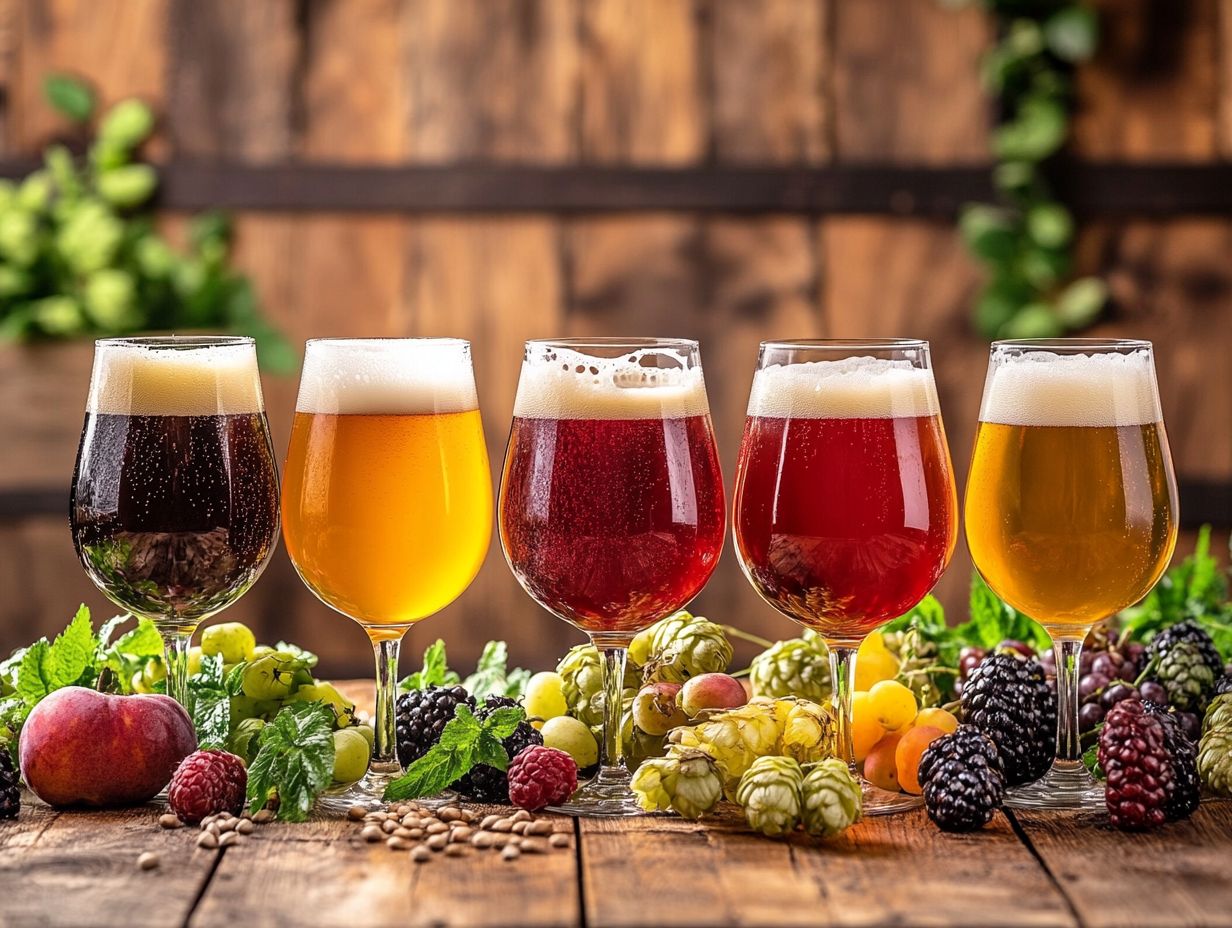
In your brewing journey, you’ll discover that beyond just yeast and hops, a variety of ingredients can significantly influence the flavors crafted during fermentation. This adds remarkable depth and complexity to the process. Ingredients such as fruit, spices, and even local flora can introduce unique elements that elevate the flavor profile of your beer, much like the microbiota that influence traditional fermented foods.
The craft brewing scene continues to evolve. Brewers are now boldly experimenting with additional ingredients, creating distinctive flavors that appeal to beer enthusiasts eager for new experiences.
For instance, adding citrus fruits like oranges and lemons imparts a zesty acidity that beautifully balances sweetness. Meanwhile, exotic spices like coriander or cinnamon can lend warm undertones that enhance the overall taste. Exploring these ingredients can lead to unique brewing setups that emphasize traditional brewing methods alongside modern brewing science.
Innovative trends, such as incorporating wildflowers or herbs, have also gained popularity, enabling brewers to craft seasonal offerings that reflect the essence of local terroir. Sours infused with exotic fruits or barrel-aged beers featuring unique ingredients showcase the boundless creativity of brewers, inviting you to explore a rich spectrum of flavors that redefine your drinking experience. Breweries like Br u Supply emphasize the importance of unique brewing techniques to create distinct products.
What Are the Most Common Flavors Produced by Fermentation?
Fermentation unveils a remarkable spectrum of flavors, many of which have become hallmark markers of specific craft beer styles, enriching the sensory adventure for those who indulge. These flavors embody the essence of brewing chemistry.
You will often encounter fruity esters, spicy phenols, and an intriguing array of sour notes each contributing unique traits that define your brewing experience, much like how Mara King and Song So Kim explore fermentation food flavors.
By grasping these common flavors, both brewers and consumers can deepen their appreciation for the nuances of various beers, elevating their tasting encounters to new heights and enhancing their overall brewing experience.
Get creative with your brewing and explore the exciting world of flavors waiting for you!
What Are Esters and How Do They Affect Beer Flavor?
Esters are magical compounds that are produced during fermentation and play an important role in shaping the overall flavor profile of your beer, contributing to its unique characteristics. They often introduce delightful fruity notes reminiscent of bananas, apples, and tropical fruits.
These compounds form through the interaction between yeast and alcohol, elevating the sensory experience of the beer and making it more enticing for you, the consumer. By understanding the role of esters in fermentation, you can appreciate how brewers craft beers with intentional flavor characteristics that resonate with your palate, showcasing the innovation and artistry of beer brewing.
Different yeast strains generate a variety of esters, each influencing beer styles in distinct ways and contributing to the unique flavors of different beers. For example, Belgian ales are famous for their prominent fruity esters, showcasing notes of pear and clove, while English ales tend to highlight subtler fruity characteristics like apple and plum.
The iconic hefeweizen, for instance, boasts banana and clove notes that arise directly from the specific yeast used. Conversely, American IPAs may feature tropical fruit esters that harmonize beautifully with hop profiles.
Brewers can manipulate ester levels by carefully selecting yeast and managing fermentation conditions, crafting a tailored experience for you as you explore the diverse and fascinating world of beer flavors and the brewing process.
What Are Phenols and How Do They Contribute to Beer Flavor?
Phenols are an intriguing class of flavor compounds that emerge during fermentation, offering a spectrum of flavors that can range from spicy and smoky to herbal and medicinal in your beer, adding to its complex flavors.
These compounds typically result from the breakdown of polyphenols found in the malt, and they can profoundly influence your beer’s flavor profile. Managing phenolic compounds effectively during fermentation is essential for any brewer aspiring to craft balanced beers that showcase these complex flavors.
The origins of phenols can vary widely, stemming from different yeast strains, specific malt types, the chemistry of the water used, and the brewing environment.
Certain styles, like Belgian wits and specific German weizens, are particularly lauded for their unique estery and phenolic flavors, conjuring delightful memories of clove, banana, and other spicy nuances. However, if you don t keep a close eye on phenol levels, they might dominate the palate, leading to unwelcome medicinal or antiseptic notes.
Select yeast strains known for their appealing phenolic traits to achieve the perfect balance, illustrating the importance of understanding fermentation methods. This approach ensures that your beer presents a harmonious blend of flavors, delighting a diverse array of palates.
How Can Brewers Control and Manipulate Fermentation Flavors?
As a brewer, you possess the remarkable ability to exert precision over fermentation and manipulate flavors through a variety of techniques, including traditional methods and ancient techniques.
This mastery enables you to craft beers with specific taste profiles that resonate with a diverse audience. By adjusting key factors like temperature, fermentation duration, and yeast strain selection, you can shape the final character of your beers in both expected and delightful ways.
Utilizing brewing methods that enhance distinct characteristics enriches your brewing experience and gives you the power to create innovative beers that challenge the conventions of traditional brewing.
Dive into brewing today and uncover the incredible flavors you can create!
What Techniques Can Be Used to Enhance or Suppress Certain Flavors?
As a brewer, the techniques you use can enhance or suppress flavors during fermentation. This greatly shapes the final beer profile, allowing you to craft a tailored tasting experience and demonstrate your mastery of fermentation techniques.
Methods such as late hopping, temperature adjustments, and the strategic use of specific yeast strains enable you to amplify desired flavors while mitigating any unwanted characteristics. This ensures that your brew is balanced and meets consumer expectations.
Understanding these techniques is essential for anyone looking to refine their craft and produce high-quality beers and innovative beers.
For instance, late hopping where you add hops during the final stages of the boil or even during fermentation preserves delicate, volatile aromatic compounds. This imparts a fresh hop aroma without the clashing bitterness.
Managing temperature during fermentation can significantly influence the esters and phenols produced by the yeast. This results in fruity or spicy notes that enhance the overall profile of your beer.
Consider the approach taken with temperature-regulated fermentation in Belgian-style ales. Specific temperatures encourage the development of characteristic banana and clove flavors, leading to a drinking experience that’s both complex and enjoyable. Such techniques highlight the ingenuity involved in craft brewing.
Mastering these techniques will elevate your brews and captivate a diverse audience, setting yourself apart in the world of brewing and contributing to the craft beer community.
How Do Different Strains of Yeast Impact Flavor Profiles?
Different strains of yeast are essential in shaping the flavor profiles of your beers, each bringing its unique characteristics to the fermentation process. This directly influences the overall fermentation potential, which refers to the ability of yeast to produce alcohol and flavors.
Your choice of yeast can significantly influence the final taste and aroma of the brew, ranging from fruity and estery to dry and phenolic.
By understanding the nuances of various yeast strains, you empower yourself to make informed decisions that lead to innovative beers. This resonates with consumers and showcases the artistry of craft brewing, a testament to the science of brewing chemistry.
Take, for example, renowned strains like Saccharomyces cerevisiae and Brettanomyces, which produce a wide range of flavors, each adding unique contributions to the final product.
When brewing American ales, you might opt for a clean fermenting strain like California Ale yeast. This boosts hop character while adding subtle fruity notes.
On the flip side, Belgian yeasts are celebrated for their complex, spicy, and fruity profiles, shining through in Trappist ales and other Belgian-style ales.
As you delve deeper into the world of craft brewing, you’ll find an exciting trend toward using wild and sour yeast strains. This allows you to explore unique flavor combinations and create a vibrant array of sour ales that challenge traditional styles and tantalize adventurous palates.
Experiment with these techniques and yeast strains to push the boundaries of your brewing and discover new flavors!
What Role Do Temperature and Time Play in Fermentation Flavors?
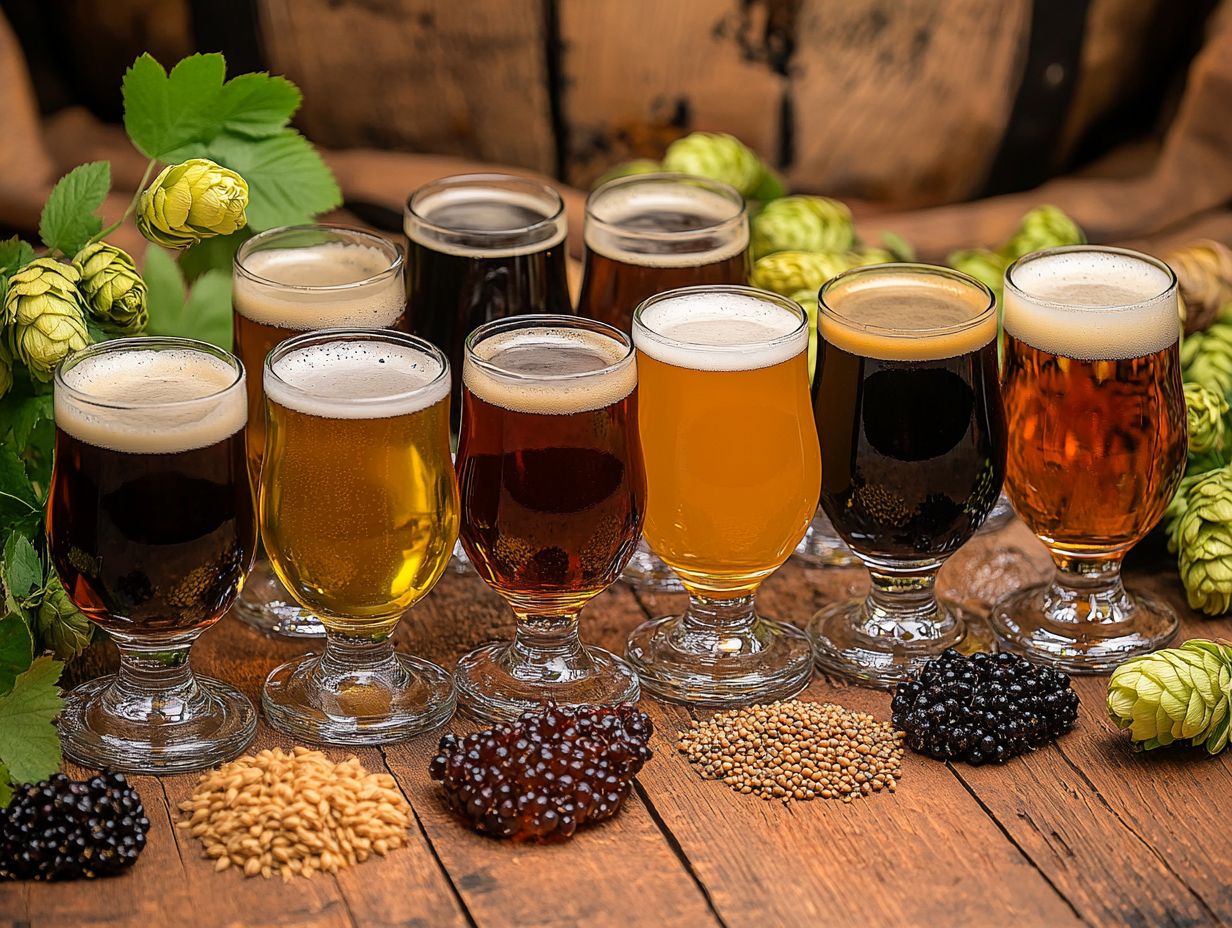
Fermentation is the heart of brewing, where temperature and time orchestrate an array of flavors that can make or break your brew. Temperature and fermentation time are pivotal elements that significantly influence the flavor development of beer during fermentation, with each factor playing a distinct role in shaping your final masterpiece by affecting flavor highlights.
Effects of Higher Temperatures:
When you choose higher fermentation temperatures, you can expect an uptick in the production of flavor compounds known as esters and phenols, responsible for more pronounced fruity and spicy notes in your brew.
Effects of Lower Temperatures:
On the other hand, opting for lower temperatures promotes cleaner flavors and a subtler profile.
By understanding how temperature, time, and fermentation intertwine, you can fine-tune your brewing process to achieve the precise flavor characteristics you desire, utilizing your knowledge of brewing science.
For example, if you’re aiming for a hop-forward IPA, consider a warmer fermentation temperature around 68-72 F to encourage those delightful tropical fruit notes to shine through, creating a complex combination of hop and ester flavors. In contrast, a classic lager thrives under cooler fermentations, typically around 50-55 F, ensuring it maintains that crisp and clean profile.
Extending fermentation time can enhance complexity, as the yeast continues to feast on sugars, contributing unique flavors along the way, as seen in the production of sour beers. Shorter fermentation durations help preserve more hop characteristics.
By experimenting with these variables, now is your chance to craft distinctive profiles that will excite and impress craft beer lovers, ultimately enhancing your brewing culture.
What Are Some Examples of Unique Fermentation Flavors in Craft Beer?
Craft beer dazzles with its unique fermentation flavors, the product of innovative brewing techniques and a creative selection of ingredients that challenge the norms of traditional brewing, reflecting the diversity of brewing methods.
You ll discover these remarkable flavors in sour beers, which deliver a delightful tartness from lactic acid bacteria, or in brews that embrace unconventional ingredients like fruit and spices, highlighting the brewer’s mastery and understanding of fermentation programs.
This adventurous exploration of unique fermentation flavors enhances the craft beer scene, inviting enthusiasts like you on a sensory journey filled with a diverse range of captivating profiles, often achieved through the use of oak barrels and other traditional brewing methods. For a deeper dive into this fascinating topic, consider exploring fermentation in craft beer regions.
How Do Sour Beers Get Their Tart Flavors?
Sour beers derive their tart flavors primarily from the fermentation of lactic acid bacteria and wild yeast, crafting a distinctive profile that sets them apart from traditional styles and showcasing the potential of spontaneous fermentation.
This fermentation process often involves techniques like barrel aging, allowing the beer to interact with wild microorganisms that contribute to its complex flavor. Understanding the role of these elements is crucial for you as a brewer if you aim to create sour beers that truly captivate the palate with their unique and refreshing characteristics.
One of the essential aspects of sour beer production lies in using specific strains of bacteria, such as Lactobacillus and Pediococcus, which produce lactic acid during fermentation. You might also find that Brettanomyces yeast can impart those funky, fruity notes that enhance the beer s complexity.
Iconic sour styles like Berliner Weisse and Gose showcase a spectrum of flavors, ranging from light and refreshing with hints of citrus to rich and full-bodied with underlying notes of oak and earthiness. The interplay between these microorganisms is vital, as it influences not just acidity but also the aromatic qualities that enthusiasts cherish.
Now that you understand the fascinating roles of temperature, time, and various fermentation techniques, don’t hesitate to dive into your next brewing session! Experiment with these elements to uncover flavors that could elevate your craft beer offerings.
What Are Some Popular Styles That Showcase Unique Fermentation Flavors?
Certain popular styles of craft beer stand out for their ability to showcase unique fermentation flavors. Each style offers characteristics that captivate a diverse array of beer enthusiasts.
Take, for example, the vibrant world of IPAs. They incorporate various fermentation methods that enhance hop profiles. This results in bright and fruity aromas that tantalize the senses.
Traditional German hefeweizens are celebrated for their delightful banana and clove notes. These flavors are a product of specific yeast strains used during fermentation.
Sour beers, including Berliner Weisse and Gose, take a different approach. They utilize specific bacteria to give beers their tangy flavor, achieving their signature tartness and creating refreshing experiences that dance on your palate.
Meanwhile, barrel fermentation plays a crucial role in crafting rich, complex flavors found in beers such as bourbon barrel-aged porters. The integration of wood and spirit notes can elevate your drinking experience to new heights.
Each of these styles vividly illustrates how fermentation techniques significantly contribute to the overall character and enjoyment of the beer you savor.
What Is the Future of Fermentation in Craft Beer?
The future of fermentation in craft beer holds remarkable promise. Brewers are delving into innovative approaches that elevate flavor and refine brewing methods.
With advancements in brewing science and an increasing enthusiasm for fermentation programs, craft breweries are set to expand the horizons of flavor exploration.
You will witness them experimenting with new ingredients and techniques that challenge traditional brewing norms. This dynamic evolution enriches the diversity of craft beer and invites you to embark on an exhilarating sensory journey alongside the brewers.
How Are Brewers Pushing the Boundaries of Flavor Through Fermentation?
Discover how brewers are transforming flavors through fermentation. They embrace experimental techniques and bold ingredient combinations to craft innovative beers that truly captivate consumers.
By leveraging the capabilities of wild yeast and exploring diverse fermentation methods, they unlock new flavor profiles that defy conventional expectations. This creative exploration enriches the craft beer landscape and showcases the passion and artistry that define brewing culture.
Take, for instance, the remarkable use of souring techniques to create spontaneously fermented beers. These evoke a complex tartness woven with fruit-forward notes.
A brewery in Oregon recently launched a limited-release raspberry sour ale. They masterfully paired soft oats with tart fruit, achieving a creamy mouthfeel that elegantly balances the sharpness of the berries.
Such innovations enhance flavor diversity and allow brewers to share their unique narratives through each brew. As these advancements continue, they may inspire collaborations and cultivate a vibrant community among enthusiasts, further elevating the overall brewing experience.
Don’t miss the chance to taste the latest innovative brews at your local craft brewery!
What New Techniques and Ingredients Are Being Explored in Fermentation?
The exploration of new techniques and ingredients in fermentation is at the forefront of your craft brewing journey, driving flavor innovation and expanding your possibilities as a brewer. By incorporating local flora and adopting cutting-edge fermentation technologies, you discover unique ways to enhance flavor profiles and create artisanal products that truly resonate with consumers.
This ongoing quest enriches your beer selection. It also fosters a vibrant brewing culture that values creativity and experimentation.
Among the noteworthy trends, you might find that the use of wild yeasts and bacteria is gaining traction. Many brewers experiment with natural fermentation techniques to cultivate complex and layered flavors. For those interested in enhancing their brewing skills, learning how to experiment with fermentation flavors can be invaluable. Take, for example, the emergence of barrel-aged sour ales, which heavily draw on these techniques, resulting in beers like the renowned Flanders Red, celebrated for its tartness and nuanced fruit notes.
You re also likely to notice how innovative ingredients such as exotic fruits, herbal infusions, and locally sourced spices are making waves. This leads to unique offerings like chili-infused IPAs or hibiscus lagers. These advancements push the boundaries of traditional brewing practices and enrich consumer experiences, contributing to a dynamic craft beer landscape that s rich in variety and creativity, ultimately elevating your brewing game.
Frequently Asked Questions
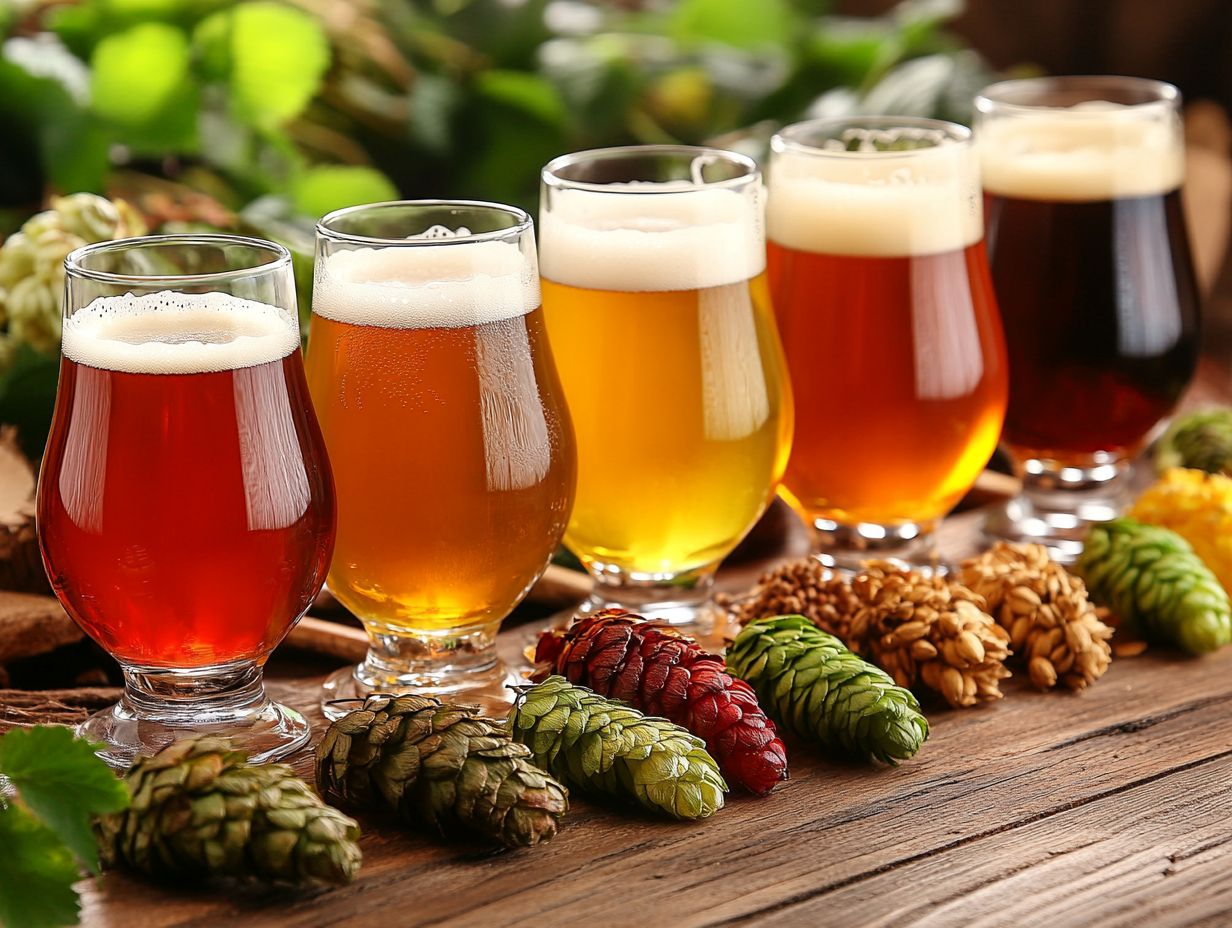
What is fermentation in craft beer?
Fermentation in craft beer is the process by which yeast converts sugars into alcohol and carbon dioxide, resulting in the production of beer.
How does fermentation affect the flavor of craft beer?
Fermentation plays a crucial role in developing the flavor of craft beer. Different strains of yeast and their fermentation conditions can produce a variety of flavors ranging from fruity and spicy to earthy and tart.
What are some common fermentation flavors found in craft beer?
Some common fermentation flavors found in craft beer include banana, clove, bubblegum, citrus, pine, and floral notes. These flavors are a result of the byproducts produced during the fermentation process.
Can fermentation flavors vary between different types of craft beer?
Yes, fermentation flavors can vary greatly between different types of craft beer. A Belgian-style wheat beer may have more fruity and spicy notes, while a stout may have more coffee and chocolate flavors from the fermentation process.
Are there any techniques that can enhance or alter fermentation flavors in craft beer?
Yes, several techniques can enhance or alter fermentation flavors in craft beer. Some brewers may use specific yeast strains, adjust the fermentation temperature, or add additional ingredients like fruit or spices to achieve desired flavors.
How can one best explore and appreciate fermentation flavors in craft beer?
The best way to explore and appreciate fermentation flavors in craft beer is to try different styles and varieties from various breweries. Pay attention to the flavors and aromas, and see if you can identify the unique fermentation characteristics in each beer.
Start your tasting adventure today!

